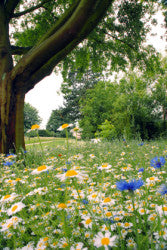Wildflower Meadows Bloom at Writtle College
 The campus is in bloom once again with three new areas of native wildflower meadows, researched and led by Andy Boorman, Senior Lecturer at Writtle. These meadows are now showing white, red, blue, purple and gold from a mix of cornfield annuals. These include; corn chamomile, poppy, cornflower, corn cockle, yellow rattle and corn marigold. The largest planting is about a half of a hectare and is located just behind the student accommodation blocks. There is another large area on the College sports grounds and the third links the engineering buildings with the main campus.
The campus is in bloom once again with three new areas of native wildflower meadows, researched and led by Andy Boorman, Senior Lecturer at Writtle. These meadows are now showing white, red, blue, purple and gold from a mix of cornfield annuals. These include; corn chamomile, poppy, cornflower, corn cockle, yellow rattle and corn marigold. The largest planting is about a half of a hectare and is located just behind the student accommodation blocks. There is another large area on the College sports grounds and the third links the engineering buildings with the main campus.
Various higher and further education horticulture students helped establish the meadows in the autumn of 2006. In subsequent years students will be able to use these areas for practical and theoretical studies. Along with the four existing experiments, they will become a focus for staff and student research within the recently established School of Horticulture. The School excels in all areas of 'green gardening' as shown by the College silver medal winning garden at this years Chelsea Flower Show.
It is anticipated that the annuals will gradually disappear over the next year or two to be replaced by grasses and perennials. As well as being colourful and supporting wildlife, the introduced annuals also help suppress less desirable weedy species. Under their canopy, Andy Boorman has already identified that ox eye daisy, yarrow, knapweed, wild carrot, common sorrel, lanceolate plantain and field scabious have germinated successfully from the seed mix. Although none of these species are threatened numbers have recently declined. Perhaps they have a good future in our parks and larger gardens?
To find out more about the courses offered by the School of Horticulture visit www.writtle.ac.uk
Article Tags:
Training & education